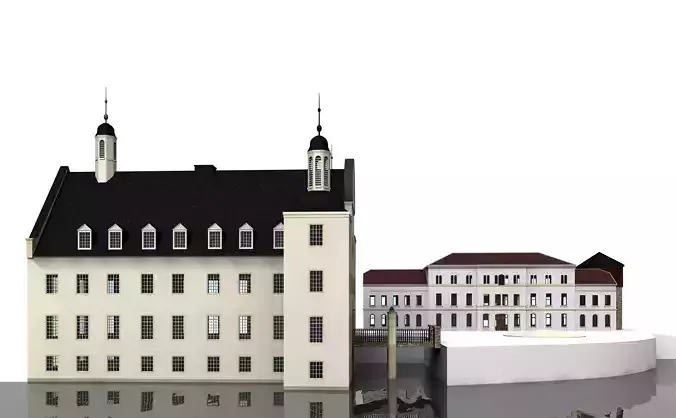1/13
With your purchase you receive the 3D building model as DAE, 3DS, C4D and SKP for immediate download. (see details)
Schloss Borbeck is a moated castle in Essen. It is situated in the suburb of Borbeck and from the 14th century it was the castle residency of the Essen sovereign abbesses. It received its present form in the 18th century. Since the 1980s, the building has been used as a venue for further training courses and cultural performances.
The three-storey main building is surrounded by a six to nine meters wide moat, which ends in a castle pond to the north. It owes its present, sober acting appearance conversion and extension work in the first half of the 18th century. The northern part of the light plastered rectangular building dates back to its two square towers at the corners and curved pediment from the Renaissance period, but was later changed to Baroque forms. The masonry of its main edifice stands on a 16 × 18-meters-plan and was built in the mid 17th century. He joins a south five windows at full extension, was probably begun in 1744. The gable roof of the building has on two roof slopes a series of dormers. At the southern end of its ridge is a ridge turret with a small bell. At both corners of the north facade, four storey corner towers, which are completed by a curly hood with an octagonal lantern rise. Both the towers and the buildings are accented by Eckquaderungen, but they are now hidden under the plaster. A 13-meter long stone bridge leads to the main entrance. It dates from the 19th century, replacing a wooden bridge, the bilateral central pillars were reused from Haustein.
Fortified residential structure of medieval EuropeThis article is about medieval fortifications. For other uses, see Castle (disambiguation).A castle high on a rocky peninsula above a plain. It is dominated by a tall rectangular tower rising above a main building with steep slate roof. The walls are pink, and covered with a sculptural pattern. There is a variety of turrets and details.The Alcázar of Segovia in Spain overlooking the cityA castle of square plan surrounded by a water-filled moat. It has round corner towers and a forbidding appearance.Built in 1385, Bodiam Castle in East Sussex, England, is surrounded by a water-filled moat.
Santa Maria da Feira Castle in Portugal, with its 15th-century pinnaclesA castle (from Latin: castellum) is a type of fortified structure built during the Middle Ages by predominantly the nobility or royalty and by military orders. Scholars debate the scope of the word castle, but usually consider it to be the private fortified residence of a lord or noble. This is distinct from a palace, which is not fortified; from a fortress, which was not always a residence for royalty or nobility; and from a fortified settlement, which was a public defence – though there are many similarities among these types of construction. Usage of the term has varied over time and has been applied to structures as diverse as hill forts and country houses. Over the approximately 900 years that castles were built, they took on a great many forms with many different features, although some, such as curtain walls and arrowslits, were commonplace.
A European innovation, castles originated in the 9th and 10th centuries, after the fall of the Carolingian Empire resulted in its territory being divided among individual lords and princes. These nobles built castles to control the area immediately surrounding them and the castles were both offensive and defensive structures; they provided a base from which raids could be launched as well as protection from enemies. Although their military origins are often emphasised in castle studies, the structures also served as centres of administration and symbols of power. Urban castles were used to control the local populace and important travel routes, and rural castles were often situated near features that were integral to life in the community, such as mills, fertile land, or a water source.
Many castles were originally built from earth and timber, but had their defences replaced later by stone. Early castles often exploited natural defences, lacking features such as towers and arrowslits and relying on a central keep. In the late 12th and early 13th centuries, a scientific approach to castle defence emerged. This led to the proliferation of towers, with an emphasis on flanking fire. Many new castles were polygonal or relied on concentric defence – several stages of defence within each other that could all function at the same time to maximise the castle's firepower. These changes in defence have been attributed to a mixture of castle technology from the Crusades, such as concentric fortification, and inspiration from earlier defences, such as Roman forts. Not all the elements of castle architecture were military in nature, so that devices such as moats evolved from their original purpose of defence into symbols of power. Some grand castles had long winding approaches intended to impress and dominate their landscape.
Although gunpowder was introduced to Europe in the 14th century, it did not significantly affect castle building until the 15th century, when artillery became powerful enough to break through stone walls. While castles continued to be built well into the 16th century, new techniques to deal with improved cannon fire made them uncomfortable and undesirable places to live. As a result, true castles went into decline and were replaced by artillery forts with no role in civil administration, and country houses that were indefensible. From the 18th century onwards, there was a renewed interest in castles with the construction of mock castles, part of a romantic revival of Gothic architecture, but they had no military purpose.
REVIEWS & COMMENTS
accuracy, and usability.














